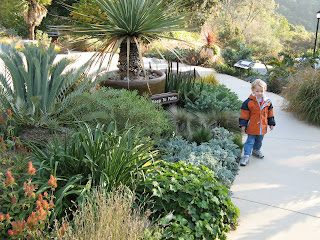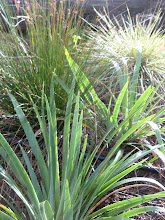On Saturday, I took a trip over to Berkeley for the first time to check out their botanical garden. My brother and his kids came too. There's Peter Jon providing some sense of scale.

The garden is beautiful and I can't remember ever being more tempted to grow some of the exotic plants of the world. Euphorbia, though often ugly and always poisonous, is a genus that I've considered collecting. Already I have the succulent E. bupleurifolia, E. horrida horrida, and the common E. milii. In the succulent greenhouse there were a few that caught my eye.
Here's the top of the euphorbia above, with some interesting crested Pachipodium behind it.


E. woodii is one of the weirder ones I've seen. E. greenwayi, below, has beautiful patterns on its stems.

When I think of Ericas, I think of the British moor variety. I've never seen one as interesting as this one in the South African collection. It's E. sessiliflora.

In the tropical greenhouse I saw Amorphophallus titanum, the plant with the world's largest unbranched inflorescence (not flower because it's actually made up of many many flowers). You can see the huge spadix, which sports tons of orange/red fruit.


This plant deserves mention because it is the most colorfully-fruited sedge I've ever seen. It's Carex baccans.

And while we're in the sedge family, I should point out this giant Ghania sp. from New Zealand.
 Here's the CA native, Coreopsis gigantea, out of its summer dormancy, with some silver Dudleya spp.
Here's the CA native, Coreopsis gigantea, out of its summer dormancy, with some silver Dudleya spp.
The CA garden was nice too. There were beds of native bulbs, an alpine area, and many other wonders. Not only were the collections nice, but it was apparent that the plants are well cared for. I reccomend a visit.



